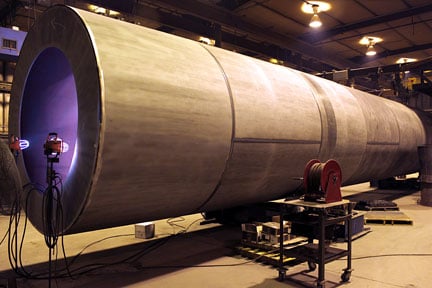Drying plays a critical role in the agglomeration process. When used prior to agglomeration, drying prepares material feedstock for agglomerate formation, and has a direct effect on how material will perform during agglomeration. Used after agglomeration, drying cures pellets into their final, strong form. In both applications, drying is vital to producing a premium end product.
Pre-Drying
In order for agglomeration to occur, feedstock must be at the ideal moisture level. As such, it can be necessary to dry material prior to the actual agglomeration stage of processing.
Implementing a drying system such as a rotary dryer prior to agglomeration brings material feedstock down to the level of moisture needed for optimum agglomeration to occur. This reduction in moisture also helps to improve subsequent processing steps in the pelletizing plant, by reducing the potential for issues like clumping, which can be common with hygroscopic materials, such as potash. If not dried first, materials such as these can quickly clog subsequent processing equipment, causing processing issues, inefficiencies, and even problems with the end product.
Drying in the Pelletization Process
As a post-agglomeration step, drying helps to refine the end product. In pelletizing, drying essentially cures the “green” (wet) pellet into its final, hardened form. This is done by removing moisture to bring the pellet down to the desired moisture level of the end product. This improves handling, as well as end product characteristics by creating a strong pellet that is capable of withstanding further handling and transportation, but can still break down when needed. When carried out in a rotary dryer, the drying stage has the added benefit of “polishing” the pellets – further rounding them as they tumble through the drum.
With some materials, a co-current air-flow serves to flash off residual moisture as material enters the drum. This creates a hardened, re-crystallized surface on the pellet or granule.
To reduce potential caking issues during the drying stage, knocking systems are often utilized to dislodge any material that may be sticking to the interior of the drum. Again, this is ideal in situations where hygroscopic materials are being processed.
Drying in the Compaction Process
Because compaction is a dry process, typically not requiring a binder, drying is often not needed.
However, a drying stage is sometimes added in order to improve resistance to attrition. Granules formed in the compaction process can be wetted and then dried, a process which serves to fill in any surface cracks, and when carried out in a rotary dryer, breaks off any loose edges, further polishing the granules.
For materials that do utilize a binder during the compaction process, and therefore do require a drying stage, a dryer may be added to reduce the moisture content down to the desired level to produce the final agglomerate.
How Drying Works
With most materials, reaching a target moisture range (or even an exact percentage) is required for the final product. Choosing a dryer that is designed around the unique requirements of the material to be processed will produce the best results.
Characteristics such as a material’s angle of repose, bulk density, specific heat, and more, will all have an effect on how the material will behave in a dryer, and subsequently, how that dryer should be designed to work with the material to produce the desired results.
Rotary dryers work by tumbling agglomerates in a drum for a set retention time. As the drum rotates, flights pick up material, carrying it over, and showering it through the process gas. This maximizes heat transfer between the material and process gas, and offers a uniform, efficient drying solution.
Fluid bed dryers work by suspending agglomerates in an air stream, causing the material to behave in a fluidized state. This too, is an efficient drying solution for agglomerates.
A quick note on choosing an industrial dryer…
When it comes to drying bulk solids and agglomerates, the choice often comes down to whether a rotary dryer or fluid bed dryer is the best choice. The choice is sometimes dictated by the industry or material, with fluid bed dryers typically serving the pharmaceutical and food industries, and rotary dryers serving more industrial applications such as fertilizers and minerals. It’s worth noting too, that fluid bed dryers are less suited for heavy materials such as ores, because it requires so much energy to fluidize them. Generally speaking, however, both dryers are a sufficient choice, with each offering their own advantages and disadvantages.
Rotary dryers are valued for their high throughput capacities, their heavy-duty build, and their ability to accept variance in feedstock.
Fluid bed dryers offer a smaller footprint, and improved opportunity for operational growth.
For a more detailed look at choosing between these two industrial dryers, see Rotary Dryer or Fluid Bed Dryer.
Drying is an important part of the agglomeration process, from preparing a material for agglomeration, to producing a premium end product. While drying is required after pelletization, a drying step is not necessary, but sometimes desirable, when working with compaction granulation. Both rotary dryers and fluid bed dryers are a suitable choice for drying bulk solids and agglomerates, but rotary dryers offer increased capacities, and heavy-duty construction.



